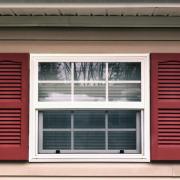How to Pick Shutter Color For Your Home
The shutter color you choose plays a major role in the impression your home makes. The right color will complement or contrast the colors already showcased on your house, and create a cohesive look for your entire exterior palette.
White and colors in the same tonal family are foolproof options for light home exteriors, and dark houses can carry bold shades like red, purple, and green with panache.
Brown
As a natural material that can enhance the look of any exterior, wood is an ideal option for shutters. Whether you choose raised panel, louvered, or board and batten (BnB), the color of your shutters will complement or contrast the colors of your window trim, roof, siding, and other architectural features on your home.
Light browns are great choices for shutter colors, as they pair well with most home styles. Dark browns also work well, especially on homes with brick or stone exteriors.
Light Green
If you’re seeking a vibrant color option that complements your home, light or dark green is a good choice. This shade is a great complement to homes with earthy characteristics, especially those made of wood, stucco or tan brick. Many homeowners choose to pair this shade with tan or gray exteriors, but it also works well with stone and stucco.
White
For homeowners who prefer a more classic look, white shutters work well with almost any house color. White shutters can also help a smaller home appear larger, when paired with white window trim. Beige and earthy tones are also great choices for shutters, as they offer a natural warmth and a window-enlarging effect similar to white. If you’re not sure which color is right for your home, consult with a local exterior painter. Professionals can use a photo of your home to identify the perfect shutter shade and create a custom color match. This traditional approach ensures your home’s aesthetic is consistent throughout. It also helps you find a color that will stand the test of time.
Yellow
Some homeowners want to use their shutter color to create a pop of personality for their home. Bright, eye-catching shades like yellow are a good option for this purpose as they provide a natural warmth and can draw attention to the windows. Yellows of all shades also pair well with a range of other colors, such as brown, green, and blue.
Light yellows are also a great choice for shutters. They can add a fresh, lively look to your home’s exterior and pair nicely with most colors, including olive green, brown, and blue.
For a classic and timeless choice, gray shutters complement yellow, tan, white, and brown exterior home colors. A light gray shade, such as Silver Mist by Farrow & Ball, creates a soft and delicate effect while a darker gray provides a bold contrast.
Beige
Earth tones, including browns and tans, are a safe choice for shutters. They pair well with a wide variety of exteriors, and they help to create a sense of natural warmth. These shades also offer window-enlarging effects.
When it comes to choosing shutter color, many homeowners are unsure of whether they should match or contrast their house’s current aesthetic. While both options have their merits, it’s important to carefully consider the colors of your home’s trim and siding before making a decision. This will ensure that your shutters don’t clash or blend in unintentionally.
Purple
Purple is another choice for homeowners who prioritize bold aesthetics, with dark purple offering a deep character to exteriors while lighter shades can create a more cute and fun-looking look. Like beige, purple pairs well with a variety of colors, including tan, cream, and gray.
Blue
Blue is another popular choice for shutters, as it’s a classic shade that compliments almost any home exterior. Deep cornflower or navy blue shades are a good choice for homeowners who want their shutters to make a statement. These hues are a great match for red, yellow, cream, tan, or gray siding and stucco or brick exteriors. They also work well on homes with cedar shingles or wood-clad structures.
As you consider your options, be sure to take color swatches outside to see how they will appear in sunlight as this can greatly affect their appearance. When in doubt, contact a professional exterior painter near you to help find the perfect shade for your home!






